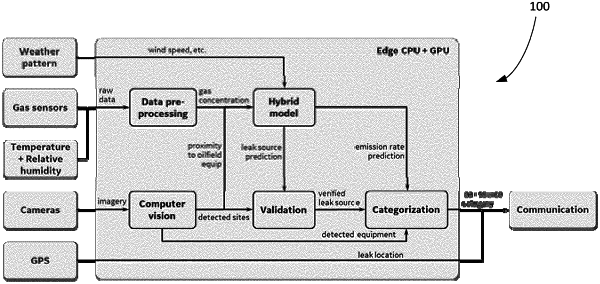| CPC G06V 20/56 (2022.01) [G06F 18/214 (2023.01); G06F 18/25 (2023.01); G06V 20/40 (2022.01)] | 5 Claims |

|
1. A distributed monitoring and analytics system for use in monitoring conditions in a remote location, the distributed monitoring and analytics system comprising:
a vehicle configured to transport people and equipment in the remote location;
a sensor package installed within the vehicle and configured to produce one or more sensor outputs as the vehicle traverses the remote location, wherein the sensor package comprises:
a gas detector configured to detect the presence of fugitive emissions in the remote location;
one or more cameras; and
a location identifier; and
an onboard computer inside the vehicle and configured to process the output from the sensor package, wherein the onboard computer is configured to:
automatically process and identify image output from the one or more cameras using machine learning algorithms and a database of known object types in the remote location;
aggregate the output from the sensor package to predict the source and rate of a fugitive emission in the remote location;
validate the source of the fugitive emission in the remote location using the output from the one or more cameras; and
identify the type of equipment leaking at the source of the fugitive emission by determining an Emission Factor based on the rate of the fugitive emission and the output from the one or more cameras, and correlating the determined Emission Factor with the type of equipment present at the source of the fugitive emission.
|